Key takeaways:
- Effective charity work in homelessness requires building relationships and understanding individual needs, focusing on empowerment rather than temporary relief.
- Advocacy is most impactful when amplifying the voices of those served; community storytelling fosters empathy and drives change.
- Engagement with stakeholders through active listening and inclusivity leads to collaborative solutions and a deeper investment in addressing homelessness.
- Measuring impact in advocacy involves both quantitative feedback and qualitative insights, recognizing the importance of emotional support alongside tangible resources.
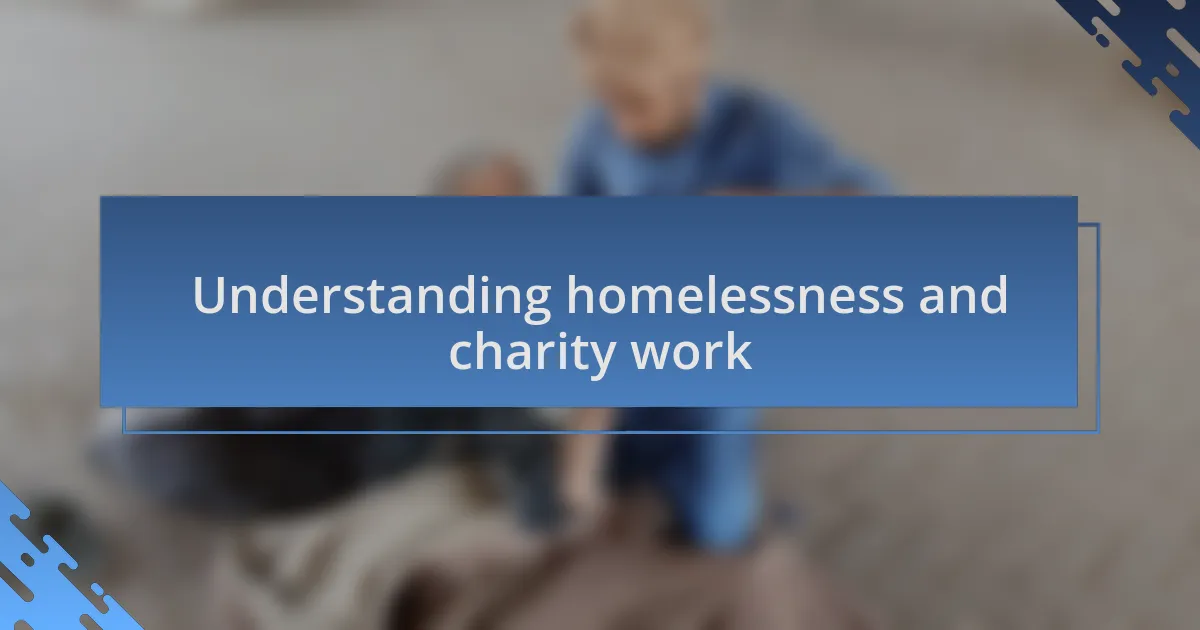
Understanding homelessness and charity work
Understanding homelessness is not just about statistics; it’s about connecting with real people who are facing unimaginable challenges. I remember meeting an elderly gentleman living in a tent behind a local grocery store. His tales of displacement and longing for connection really drove home the importance of compassionate charity work.
Charity work in homelessness often requires more than just handing out food or supplies; it’s about building relationships and trust. Have you ever considered how a simple conversation could change someone’s day? I’ve seen firsthand how a sincere exchange can provide hope and a sense of dignity to those who feel invisible in our society.
Moreover, the complexities of homelessness demand a tailored approach in charitable efforts. Treating each individual as unique, with their own story and needs, is vital. I recall a young woman I encountered who had lost her job due to illness; she emphasized that what she needed most was not just a meal but guidance to rebuild her life. This experience reinforced for me that charity is more effective when it focuses on empowerment rather than just temporary relief.
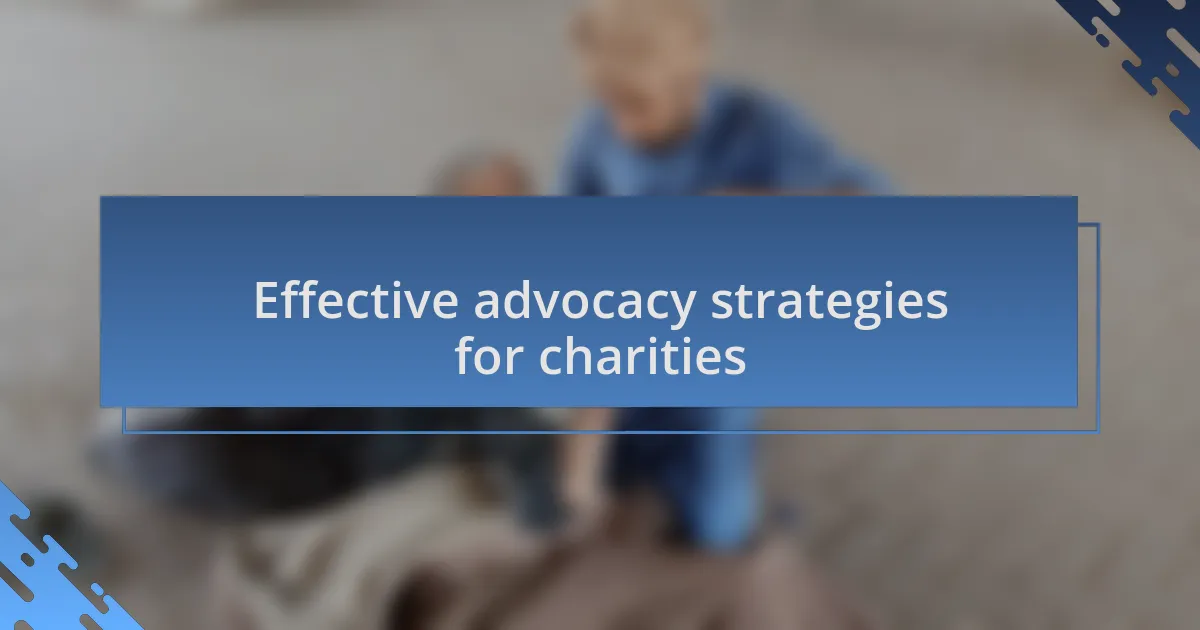
Effective advocacy strategies for charities
Advocacy is most impactful when we amplify the voices of those we serve. I recall a community meeting where individuals experiencing homelessness shared their stories and needs. Watching their courage inspire others in the room was a reminder that our role is to facilitate these conversations, not just to speak on their behalf.
Building partnerships with local businesses and organizations is another effective strategy. For instance, I worked with a nearby cafe that offered job training for homeless individuals, transforming both our outreach efforts and their lives. These collaborative initiatives not only provide resources but also foster a sense of community, bridging the gap between the housed and the unhoused.
Social media is a powerful tool for advocacy, too. I once ran a campaign highlighting the struggles faced by a homeless single mother trying to care for her children. The overwhelming response from our online community sparked further dialogue and inspired action. It reminded me of the impact storytelling can have; it cultivates empathy and drives change in ways traditional methods often cannot.
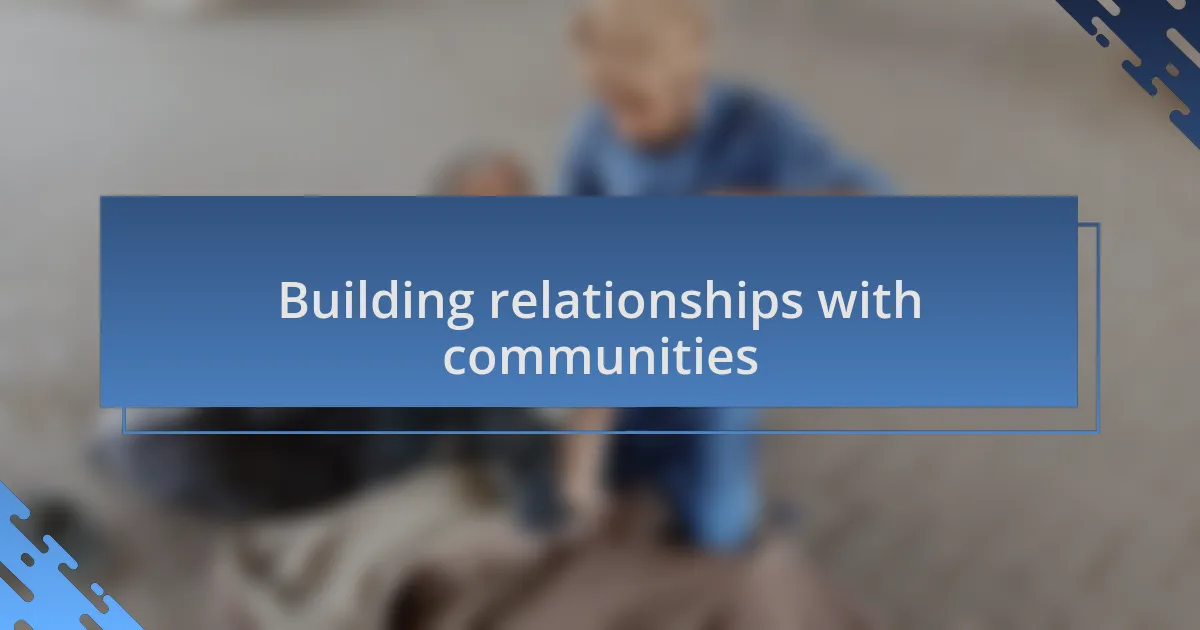
Building relationships with communities
Building genuine relationships with communities requires consistent engagement and active listening. I remember hosting a neighborhood potluck where community members, including those experiencing homelessness, shared not just food but stories that fostered mutual understanding. How can we expect to serve effectively if we don’t first know the hearts and minds of those we aim to help?
Creating an inclusive environment encourages open dialogue, which I learned firsthand during my work with a local advocacy group. We organized regular brainstorming sessions where everyone—whether a volunteer, service provider, or someone with lived experience—could voice their ideas and concerns. It was eye-opening to realize how these discussions not only shaped our programs but also strengthened our bonds with each other.
Trust-building is a gradual process, and I’ve found that it often stems from simple acts of kindness. On one occasion, a small gesture, like bringing warm blankets to a local shelter, opened up opportunities for deeper conversations about needs and aspirations. This taught me that building relationships isn’t just about the big initiatives; it’s often the small, consistent acts that lay the foundations for lasting connections.
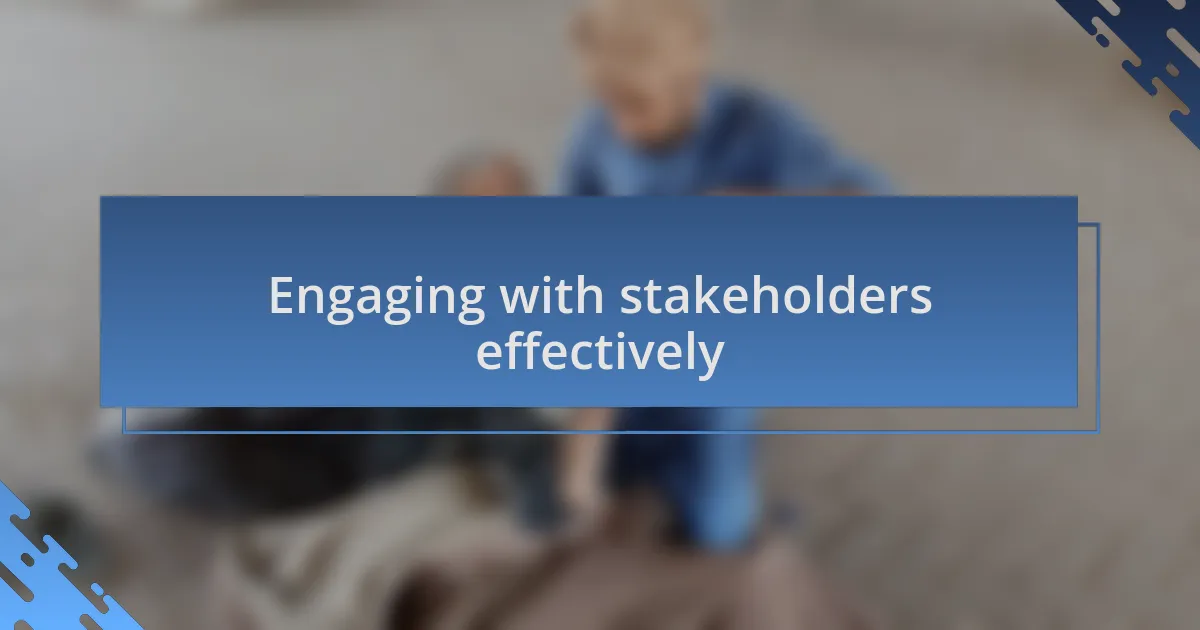
Engaging with stakeholders effectively
Engaging effectively with stakeholders involves creating an environment where each voice is valued. I recall a meeting with city officials when we discussed our plans for a new shelter. Instead of merely presenting our ideas, we invited them to share their perspectives on local issues. This exchange not only enriched our proposal but also forged a collaborative spirit that turned them into advocates for our cause.
Active listening is another key element in this process. One time, while visiting a housing development, I was struck by a resident’s comment about the lack of supportive services for parents. This wasn’t just a passing observation; it was a heartfelt plea that influenced our approach. When stakeholders feel genuinely heard, their investment in the mission deepens, and I believe this creates a shared responsibility toward solving problems together.
What if we took the time to not only inform but also learn from our stakeholders? In my experience, engaging with local businesses helped us secure resources for our initiatives. Their commitment grew when they saw the direct impact of our collaboration on the community. I believe that the more we cultivate these partnerships with openness and respect, the more robust our collective efforts will be in addressing homelessness.
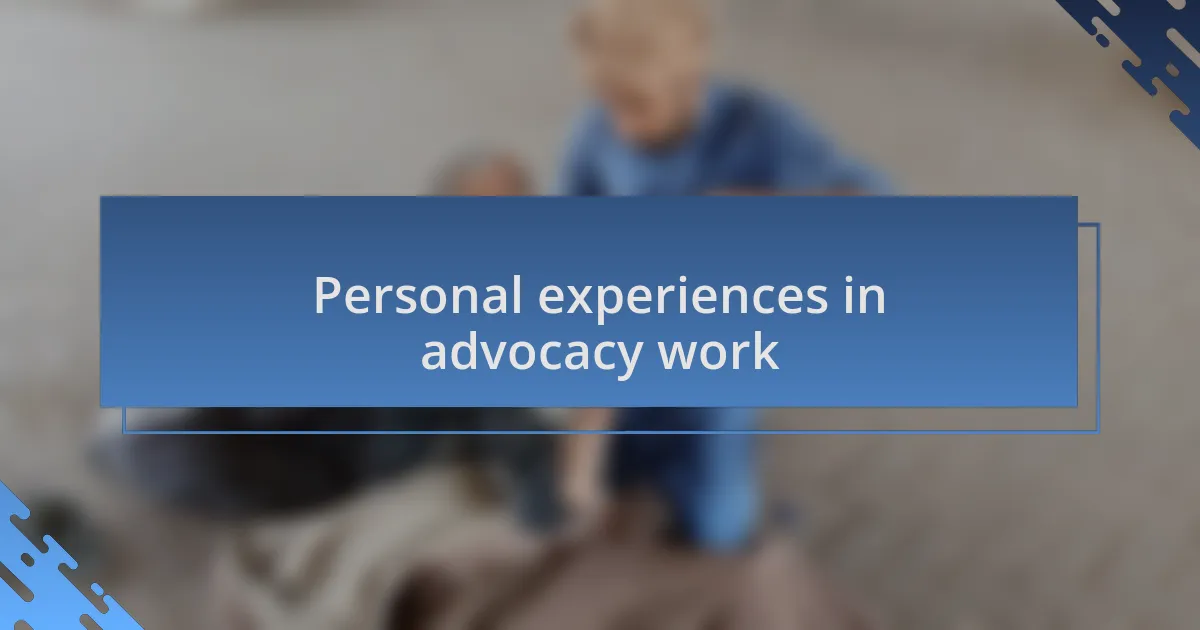
Personal experiences in advocacy work
One of my most transformative experiences in advocacy work came when I volunteered at a local homeless outreach event. I remember meeting a woman named Sarah, who shared her story of losing her job and, subsequently, her apartment. Her resilience struck me profoundly, and it made me realize how important it is to amplify individual voices. What are we doing, I asked myself, if not creating spaces for these personal narratives to shape our initiatives and policy recommendations?
On another occasion, participating in a community forum opened my eyes to the importance of emotional connection in advocacy. A father stood up and articulated his struggles to keep his children safe while living in a shelter. His raw emotion resonated with many attendees, including myself. It made me wonder: How can we ensure that these heartfelt stories don’t just fade after a moment? I believe by weaving them into our advocacy strategies, we can create a more compelling case for systemic change.
There was also that pivotal day when we organized a listening session with people experiencing homelessness. I was surprised by the depth of insights they provided—it was not just about housing but also mental health and access to services. Each person’s story carried a weight that statistics often overlook. How can we truly advocate for change if we aren’t willing to sit down and hear these narratives? Embracing these dialogues not only enriches our work but also fosters a sense of community and belonging in our advocacy efforts.
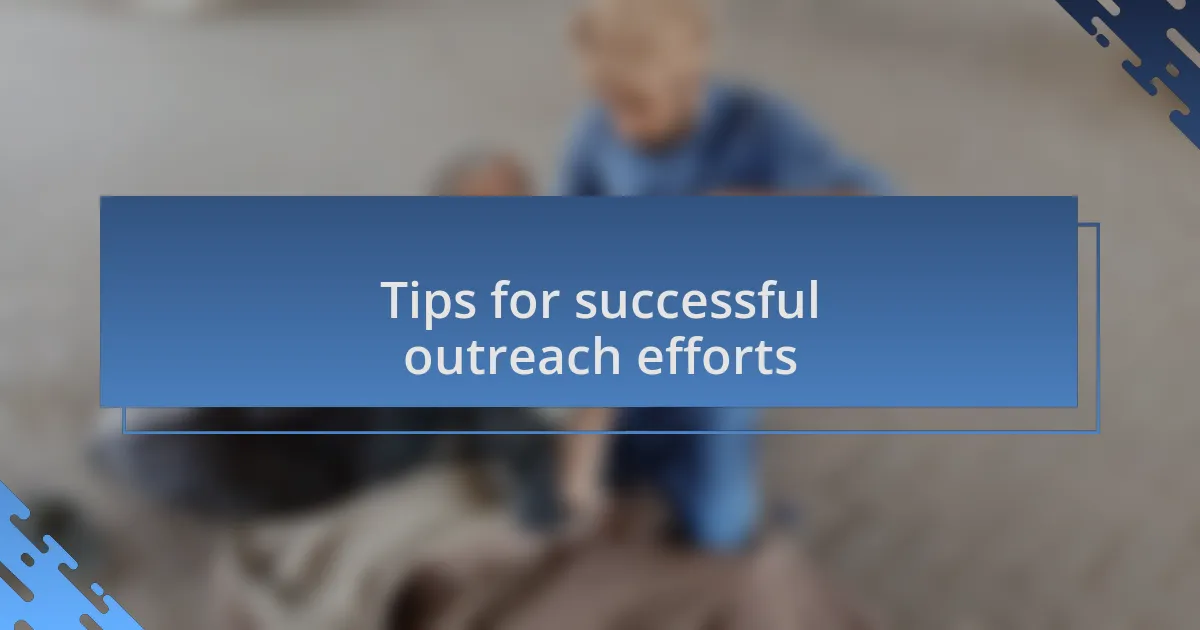
Tips for successful outreach efforts
When it comes to outreach efforts, I can’t stress enough the importance of building genuine relationships. One approach that worked well for me was to partner with local businesses for community events. By sharing resources and tapping into their networks, we created a welcoming space for homeless individuals to access vital services. Have you ever noticed how a simple coffee shop can turn into a hub of support? That’s the power of community collaboration at work.
I also found that employing active listening during outreach makes a world of difference. It’s easy to enter these conversations armed with statistics and solutions, but I learned that simply listening can often yield the most significant insights. I recall a time when I prepared to share our services, only to pause and let a woman express her fears about getting back on her feet. Hearing her articulate those worries profoundly shaped how we approached our program. Do we truly understand what people need, or do we rush to assumptions? It’s critical to take that step back.
Finally, consistency in follow-up is crucial for effective outreach. I once reached out to individuals we had services for a month later, just to check in. You wouldn’t believe how much this small gesture meant to them. Many of those I spoke with felt overlooked after initial meetings, leading them to disengage from support systems. It made me realize—how often do we close the door after opening it? Regular follow-ups build trust and encourage ongoing dialogue, making our outreach efforts not just a one-time interaction but a continuous relationship.
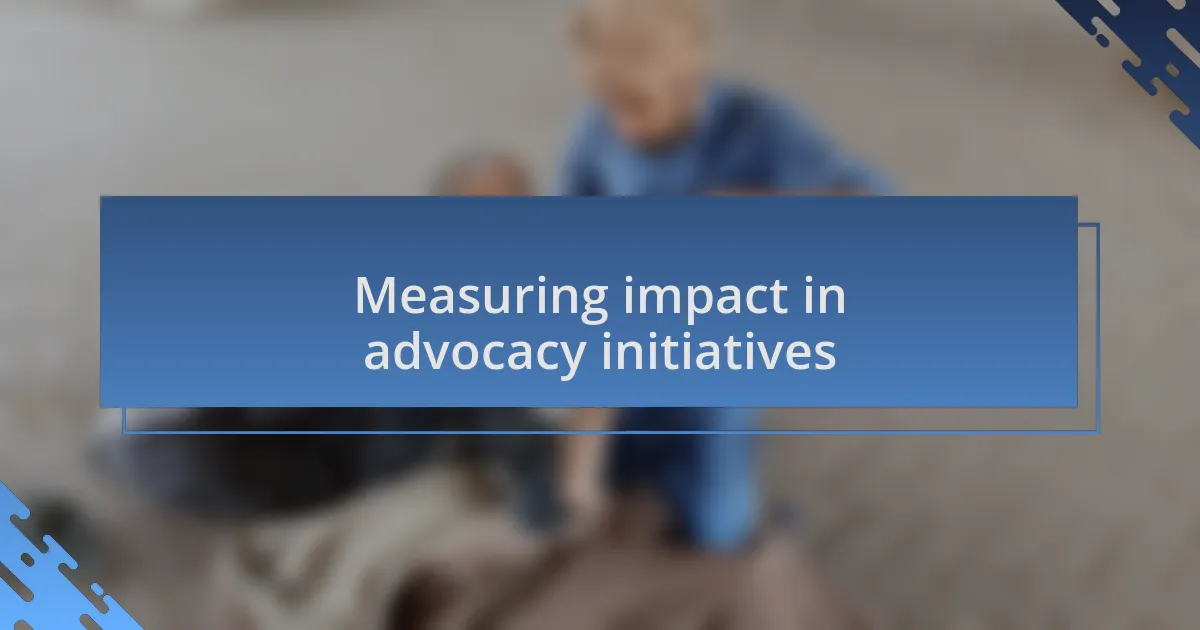
Measuring impact in advocacy initiatives
Measuring impact in advocacy initiatives is a nuanced task that requires both quantitative and qualitative approaches. One effective method I’ve used is gathering direct feedback from the individuals we aim to help. For instance, after implementing a new program, I designed simple surveys that asked participants to share their experiences and outcomes. It’s amazing how much clarity we can gain from their voices. Have you ever gathered insights from those you serve? It might just reshape your entire perspective.
In my experience, tracking changes in behavior or attitudes can also be revealing. I remember a specific initiative focused on mental health awareness that resulted in a noticeable shift in the community’s willingness to seek help. We documented these changes through follow-up interviews over several months. It was incredible to see individuals who once felt entirely isolated share their stories of seeking support—I realized then that impact isn’t solely in numbers; it’s also about the stories behind them.
Another crucial aspect of measuring impact is recognizing and adapting to the emotions involved in advocacy work. During a campaign, I monitored not just the outreach statistics but also the deeper emotional shifts within the community. Engaging with people who expressed newfound hope, or those still grappling with despair, highlighted the necessity of emotional support alongside tangible resources. Isn’t it vital to remember that metrics alone cannot capture the entirety of our work? By understanding both the data and the feelings, we can better tailor our advocacy strategies for lasting change.